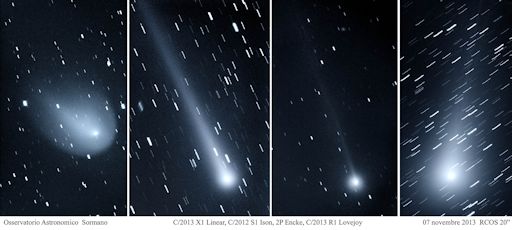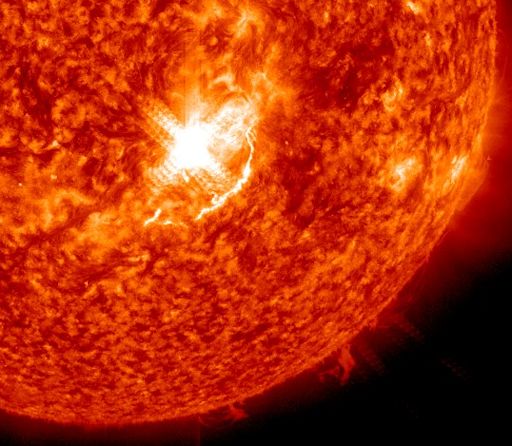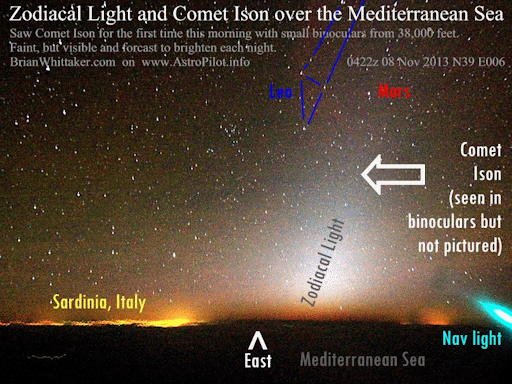AURORA WATCH: NOAA forecasters estimate a 40% of polar geomagnetic storms on Nov. 10th as a stream of solar wind buffets Earth's magnetic field. High-latitude sky watchers should be alert for auroras. Solar flare alerts: text, voice.
YET ANOTHER X-FLARE: As predicted, sunspot AR1890 has unleashed another strong flare, an X1-class explosion on Nov. 10th at 05:14 UT. NASA's Solar Dynamics Observatory recorded a bright flash of extreme ultraviolet radiation from the blast site:
This is the third X-flare from AR1890 since Nov. 5th, and all three have something in common: brevity. AR1890 tends to produce impulsive flares, peaking sharply in a matter of minutes or less. Often, brief flares do not produce coronal mass ejections (CMEs), but this one could be an exception. A movie of the flare shows a plume of material lifting off the sun shortly after the UV flash. That could be the beginnings of an Earth-directed CME. Stay tuned for further analysis. Solar flare alerts: text, voice.
Realtime Space Weather Photo Gallery
COMET ISON NOW A BINOCULAR OBJECT: Comet ISON is brightening as it approaches the sun. Multiple observers now report that it is a binocular object. "I finally saw Comet ISON for the first time using small binoculars!" says pilot Brian Whittaker. He was flying 38,000 feet over the Mediterranean Sea on Nov. 8th when he took this picture showing where to look:
"It was faint, but is predicted to brighten and move each day," he adds. "Exciting! "
"I have made my first confirmed binocular sighting of C/2012 S1 ISON as well," reports Pete Lawrence of Selsey UK on Nov. 9th. "ISON's head appears small and stellar through a pair of 15x70s optics."
Comet ISON is currently moving through the constellation Virgo low in the eastern sky before dawn. Shining like an 8th magnitude star, it is still too dim for naked eye viewing, but an increasingly easy target for backyard optics. Amateur astronomers, if you have a GOTO telescope, enter these coordinates. Special dates of interest are Nov. 17th and 18th when the comet will pass the bright star Spica. Sky maps: Nov. 10, 11, 12, 13, 14, 15, 16, 17, 18, 19.
Don't delay, because Comet ISON is plunging toward the sun for a perilous encounter on Nov. 28th. At closest approach, the comet will be deep inside the sun's corona and little more than a million kilometers from the fiery stellar surface. If ISON survives--a big IF--it could emerge from solar fire as a naked-eye comet for northern-hemisphere observers in December. Monitoring is encouraged!
BRIGHTER THAN ISON: Comet ISON is getting all the press, but it's not even the brightest comet in its own patch of sky. That would be Comet Lovejoy (C/2013 R1), one of four comets now rising in the east before dawn:

Image credits: Sormano Astronomical Observatory (Nov. 7, 2013)
Pictured from left to right are exploding Comet LINEAR X1, sungrazing Comet ISON, short-period Comet Encke, and the brightest of them all, Comet Lovejoy. All four are visible in binoculars or backyard telescopes, and Comet Lovejoy (mag. +6.0) is visible to the naked eye from dark-sky sites. Comet ISON is actually one of the faintest of the group; only expanding Comet LINEAR X1 (mag. +8) is more difficult to see.
An apparition of so many comets at once is a rare thing, and amateur astronomers are encouraged to wake up early for a tour of the pre-dawn sky. Dates of special interest include Nov. 15-18 when Comet LINEAR X1 passes by the bright star Arcturus, Nov 17-18 when Comet ISON has a close encounter with Spica, and Nov. 18-20 when Comet Encke buzzes Mercury. These stars and planets make excellent naked-eye guideposts for finding the comets. Meanwhile, bright Comet Lovejoy is approaching the Big Dipper; if you can't see it with your unaided eye, a quick scan with binoculars will reveal it. Sky maps: Nov. 10, 11, 12, 13, 14, 15, 16, 17, 18, 19.
Comet ephemerides: Comet ISON, Comet Lovejoy, Comet Encke, Comet LINEAR

Solar wind
speed: 558.8 km/sec
density: 1.5 protons/cm3
explanation | more data
Updated: Today at 1517 UT
X-ray Solar Flares
6-hr max: C3 0927 UT Nov10
24-hr: X1 0514 UT Nov10
explanation | more data
Updated: Today at: 1500 UT
![]()
Daily Sun: 10 Nov 13
Big sunspot AR1890 has a 'beta-gamma-delta' magnetic field that harbors energy for X-class solar flares. Credit: SDO/HMI
![]()
Sunspot number: 95
What is the sunspot number?
Updated 10 Nov 2013
Spotless Days
Current Stretch: 0 days
2013 total: 0 days (0%)
2012 total: 0 days (0%)
2011 total: 2 days (<1%)
2010 total: 51 days (14%)
2009 total: 260 days (71%)
Since 2004: 821 days
Typical Solar Min: 486 days
Update 10 Nov 2013
The Radio Sun
10.7 cm flux: 148 sfu
explanation | more data
Updated 10 Nov 2013
![]()
Current Auroral Oval:
Switch to: Europe, USA, New Zealand, Antarctica
Credit: NOAA/POES
![]()
Planetary K-index
Now: Kp= 2 quiet
24-hr max: Kp= 2 quiet
explanation | more data
Interplanetary Mag. Field
Btotal: 6.3 nT
Bz: 2.5 nT south
explanation | more data
Updated: Today at 1517 UT
![]()
Coronal Holes: 10 Nov 13
There are no large coronal holes on the Earthside of the sun. Credit: SDO/AIA.






